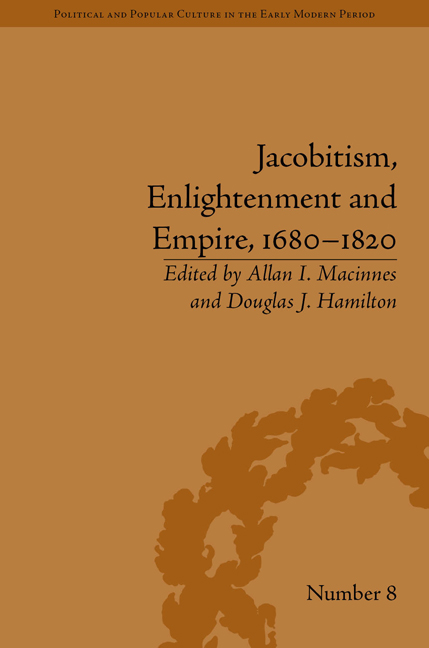Book contents
- Frontmatter
- CONTENTS
- List of Contributors
- List of Tables
- Introduction: Identity, Mobility and Competing Patriotisms
- 1 Jamie the Soldier and the Jacobite Military Threat, 1706–27
- 2 Simply a Jacobite Heroine? The Life Experience of Margaret, Lady Nairne (1673–1747)
- 3 Missionaries or Soldiers for the Jacobite Cause? The Conflict of Loyalties for Scottish Catholic Clergy
- 4 English Liturgy and Scottish Identity: The Case of James Greenshields
- 5 ‘Let Him be an Englishman’: Irish and Scottish Clergy in the Caribbean Church of England, 1610–1720
- 6 Scotland, the Dutch Republic and the Union: Commerce and Cosmopolitanism
- 7 Clearing the Smokescreen of Early Scottish Mercantile Identity: From Leeward Sugar Plantations to Scottish Country Estates c. 1680–1730
- 8 Union, Empire and Global Adventuring with a Jacobite Twist
- 9 John Drummond of Quarrel: East India Patronage and Jacobite Assimilation, 1720–80
- 10 William Playfair (1759–1823), Scottish Enlightenment from Below?
- 11 The Visionary Voyages of Robert Burns
- 12 ‘Defending the Colonies against Malicious Attacks of Philanthropy’: Scottish Campaigns against the Abolitions of the Slave Trade and Slavery
- Abbreviations
- Notes
- Index
11 - The Visionary Voyages of Robert Burns
- Frontmatter
- CONTENTS
- List of Contributors
- List of Tables
- Introduction: Identity, Mobility and Competing Patriotisms
- 1 Jamie the Soldier and the Jacobite Military Threat, 1706–27
- 2 Simply a Jacobite Heroine? The Life Experience of Margaret, Lady Nairne (1673–1747)
- 3 Missionaries or Soldiers for the Jacobite Cause? The Conflict of Loyalties for Scottish Catholic Clergy
- 4 English Liturgy and Scottish Identity: The Case of James Greenshields
- 5 ‘Let Him be an Englishman’: Irish and Scottish Clergy in the Caribbean Church of England, 1610–1720
- 6 Scotland, the Dutch Republic and the Union: Commerce and Cosmopolitanism
- 7 Clearing the Smokescreen of Early Scottish Mercantile Identity: From Leeward Sugar Plantations to Scottish Country Estates c. 1680–1730
- 8 Union, Empire and Global Adventuring with a Jacobite Twist
- 9 John Drummond of Quarrel: East India Patronage and Jacobite Assimilation, 1720–80
- 10 William Playfair (1759–1823), Scottish Enlightenment from Below?
- 11 The Visionary Voyages of Robert Burns
- 12 ‘Defending the Colonies against Malicious Attacks of Philanthropy’: Scottish Campaigns against the Abolitions of the Slave Trade and Slavery
- Abbreviations
- Notes
- Index
Summary
On the outskirts of Ayr, in the toney suburb of Alloway, stands the National Trust of Scotland Robert Burns Birthplace Museum, opened in 2011. It's a kind of bardic campus encompassing the ‘auld, clay biggin’ where Burns was born, the ruin of Alloway Kirk, the famous bridge across the Doon where Tam o' Shanter escapes from the witches, the Burns Monument and gardens, a new custom-built museum, a café and – inevitably – a gift shop selling Burns Cottage snowglobes and ‘Timorous Beastie’ fridge magnets. Among other things, the Birthplace Museum represents a ‘commodification of rootedness’, drawing tourists from across the globe to celebrate the downhome rusticity of the ‘lad was born in Kyle’. And it clearly works: Burns tourism is now worth £160 million per annum to the Scottish economy.
The legacy of Burns, more than of any other Romantic era poet, connects the local with the global. Burns's poems of Ayrshire folkways are performed throughout the world at Burns Suppers every 25th January. A global network of more than 250 Burns Clubs maintains the poet's memory. ‘Auld Lang Syne’, with its opaque local dialect, reportedly shares with ‘Happy Birthday to You’ the status of the world's most performed song. Statues of the poet, often depicted with his ploughing gear, as though rooted in the Mossgiel soil, are dotted across the globe; there are twelve in Australasia alone. Robert Burns, to adapt a famous advertisement, is the world's local poet.
- Type
- Chapter
- Information
- Jacobitism, Enlightenment and Empire, 1680–1820 , pp. 173 - 192Publisher: Pickering & ChattoFirst published in: 2014

